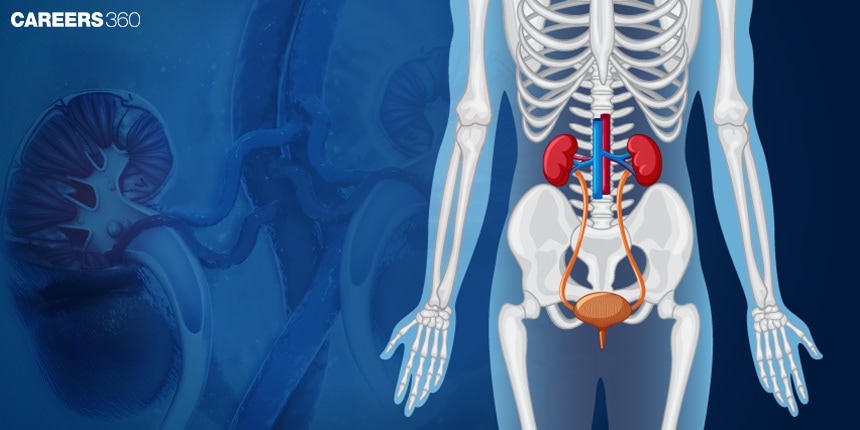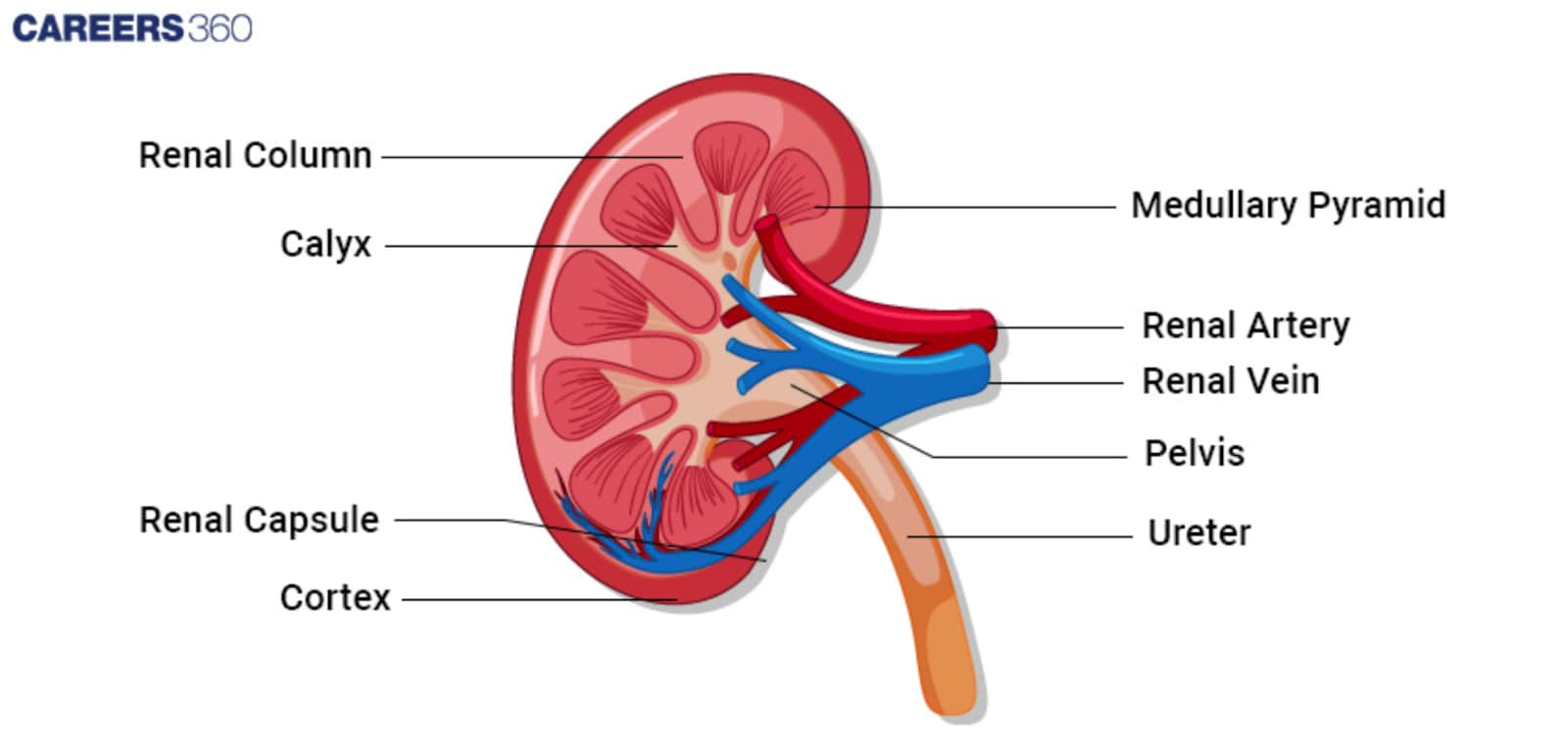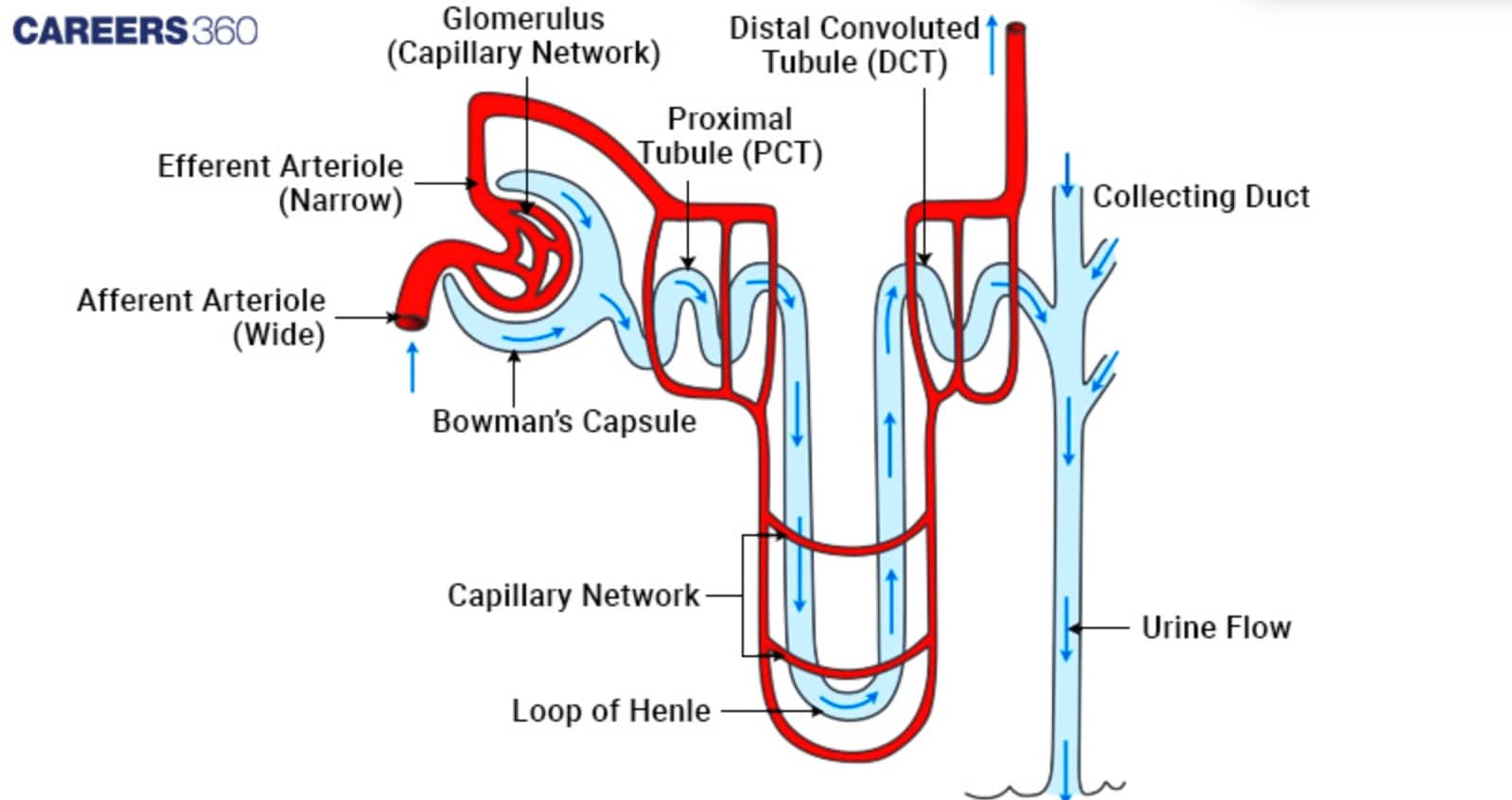Kidney and Nephron – Diagram, Definition, Function, Structure, Facts
The kidney is an important organ of the excretory system which functions to filter out waste and other excess substances in the blood. It maintains fluid balance in the body, controls blood pressure, and supports homeostasis in general. A single kidney contains millions of nephrons, which are the functional units of the kidney that filter the blood and reabsorb useful molecules while excreting waste. Questions about the structure of the human kidney are asked in competitive exams like NEET and AIIMS BSc Nursing where biology is one of the main subjects.
NEET 2025: Mock Test Series | Syllabus | High Scoring Topics | PYQs
NEET Important PYQ's Subject wise: Physics | Chemistry | Biology
New: Meet Careers360 B.Tech/NEET Experts in your City | Book your Seat now
- Human Kidney Diagram
- Diagram of the Nephron
- Structure and Function of the Kidney
- Recommended Video for Kidney and Nephron

Human Kidney Diagram
Below is the kidney anatomy diagram with its parts:

The anatomy of the kidney is discussed below:
Shape and Size: The kidneys are paired, bean-shaped organs, each being about 11-14 cm long, 6 cm wide and 4 cm in thickness. They weigh about 150 grams in adults.
Position: One on either side of the spine in the abdominal cavity, the kidneys lie directly below the rib cage. A little lower than the left, the right kidney is normally located to provide space for the bulky liver.
Cortical area: The outer part of the kidney, having renal corpuscles and the bulk of renal tubules. It is said to be the real machine for the filtration of blood and the place of urine formation.
Medulla: It is the inner portion that contains the renal pyramids. The renal columns are the visible portions of tissue between the pyramids. The renal pyramids are made of the Henle loops and collecting ducts, elements that are responsible for concentrating the urine and transporting it.
Renal Pelvis: The hollow spelt in the centre of each kidney collects urine from medullary pyramids and leads it into the ureter. So, it works as a funnel passage of urine to the bladder.
Also Read:
- MCQ Practice on Structure of Nephron
- Excretory Products and their Elimination
- Excretory System
- Body Fluids and Circulation
Diagram of the Nephron
Below is the diagram of a nephron, the main structure of the kidney:

Types of Nephrons
The basic functional unit of the kidney is the nephron, which filters the blood of waste and waste products through its functional parts like the glomerulus, Bowman's capsule, and the renal tubules, balancing the fluids to produce urine. The different types of nephron are:
Cortical Nephron
This type of nephron mostly lies in the renal cortex. They have been found with their shorter loops of Henle which lead to most of the renal bulk filtration and absorption.
Juxtamedullary Nephron
They too have long loops that dip deep into the medulla from a position close to the junction of the cortex and medulla.
Structure and Function of the Kidney
The structure and function of the kidney is discussed below:
Renal Corpuscle
Glomerulus: Ball of capillaries where filtration of blood starts. The pressure there of the capillaries pushes water, ions and small molecules out into Bowman's capsule.
Bowman's Capsule: A cup-shaped chamber surrounding that glomerulus which gathers the filtrate from the glomerulus.
Renal Tubule
Proximal Convoluted Tubule (PCT): This is the first section of the renal tubule of the nephron. Here, approximately 65% of filtered water and 65% of the filtered ions are reabsorbed.
Loop of Henle: This U-shaped loop projects into the medulla. Water and salt are reabsorbed there, concentrating the urine. It is composed of two limbs. There is a downrunning limb, which is permeable to water, and an uprunning limb, which is permeable to salts.
Distal Convoluted Tubule: This is followed by additional fine-tuning of the filtrate due to differential reabsorptions and secretion—chiefly under aldosterone influence.
Collecting Duct: It is formed by a collection of many nephrons; this at last completes the concentration of the urine and hence carries it out to the renal pelvis.
Also Read:
| Urea Cycle | Glomerular Filtration Rate |
| Ultrafiltration | Micturition |
| Disorders of the Excretory System | Dialysis |
Recommended Video for Kidney and Nephron
Frequently Asked Questions (FAQs)
The kidney's primary role is to filter the blood to remove waste products, excess fluid and electrolytes, which are passed in urine and thus excreted out of the body. Some secondary functions are to maintain blood pressure, to manufacture hormones that help in keeping the red blood cell count and to keep the general balance of fluids and electrolytes in the body.
A nephron consists of a renal corpuscle and the renal tubule which forms the functional unit of the kidney. The renal corpuscle consists of the glomerulus and Bowman's capsule. The renal tubule has a proximal convoluted tubule, Henle's loop with its descending and ascending limbs, a distal convoluted tubule and a collecting duct.
The major processes through which the nephron starts producing urine are:
Glomerular Filtration: The blood is relatively filtered in the glomerulus, and the resulting filtrate goes on to leave and come into the Bowman's capsule.
Tubular Reabsorption: Most of such things get reabsorbed from the filtrate back into the blood along PCT, Henle's loop, and DCT because the body requires them, as in the example of water, glucose, and ions.
Tubular Secretion: Further waste products and excess ions flow into the filtrate from the blood.
Excretion: In this phase, the collecting duct collects the remaining urine full of the waste product and each of the surpluses. Thereafter, it flows down to the renal pelvis to the bladder and finally gets excreted from the body.
Common kidney disorders include:
Chronic Renal Failure: This is a long-term ailment because the kidneys slowly start losing the capacity to work.
Acute Kidney Injury: Due to a sudden injury or disease, it is the loss of functional capacity by the kidneys.
Kidney Stones: Hard minerals and salts deposit within the kidneys.
Urinary Tract Infections: It is an infection in any part of the urinary system that may embrace the kidneys.
Polycystic Kidney Disease: This develops from a genetic defect that provokes the growth of cysts in the kidneys.
For Healthy Kidneys:
Remain Hydrated: Take a respectable amount of water so that all the toxins are removed with ease from the body by the kidneys.
Healthy Diet: Include in the diet fruits and vegetables, whole grains, whole wheat, and lean proteins. Reduce the usage of salt, sugar, and junk food.
Regular Exercise: Maintains body weight and blood pressure.
Avoid smoking and excessive alcohol consumption: These are dangerously harmful to kidney function.
Keep blood pressure and blood sugar under control: The big culprits leading to kidney diseases are hypertension and diabetes.
Check-ups Regularly: Regular medical check-ups help to identify the earliest kidney problems and their prompt management.
Also Read
28 Nov'24 08:16 PM
28 Nov'24 06:24 PM
28 Nov'24 12:06 PM
27 Nov'24 04:33 PM
27 Nov'24 02:40 PM
27 Nov'24 12:24 PM

